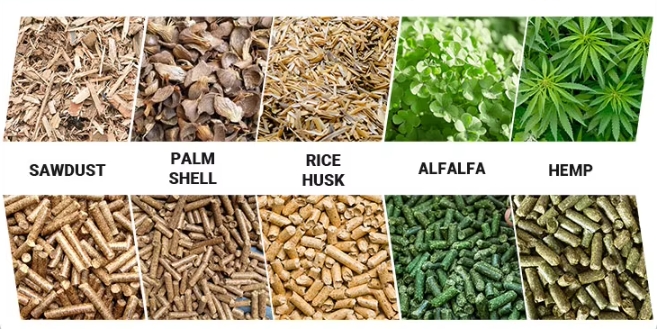There are a variety of raw materials that can be used to process biomass pellets, among which logs, wood chips, sawdust, crop stalks, shells are the most common. The following are some raw materials that can be used to process biomass pellets, which raw materials are used to do it, considering which raw material resources you have, and many factors such as sales market
1. Crop straw
Wheat straw, straw, corn straw, etc. are common crop straws, which can be used for processing biomass pellets. These straw resources are rich, is the waste in the agricultural production process, its processing into biomass particles can realize the reuse of resources, reduce environmental pollution, but also for farmers to increase a certain source of income. For example, in some rural areas, there is a huge production of corn stalks, which used to be burned on the spot, but can now be collected and processed into biomass pellet fuel for heating or fuel for small industrial boilers.
2. Energy crops
Corn cob, walnut kernel, sunflower seed shell, peanut shell, EFB, weeds and so on are energy crop raw materials. These raw materials from a wide range of sources, such as corn cob in the process of corn processing, they contain a certain energy component, after processing can become high-quality biomass pellet raw materials, can play an important role in the field of biomass energy.
Rice husks are also a crop waste that can be used to process biomass pellets. Sorghum husks are renewable. Lignin, starch and other substances can be used to increase the viscosity and hardness of the particles and reduce the cracking rate. Cellulase, xylanase and other enzymes can be used to eliminate the antigenics of sorghum husk itself and improve its particle formation effect.
3. Industrial waste
Industrial wastes such as wood chips, wheat straw, sawdust, bark and branches can be used to process biomass pellets. Take wood chips as an example, wood processing process will produce a large number of wood chips, these wood chips if not used will cause waste of resources and environmental problems, will be processed into biomass particles, can be used as a clean fuel, with a high calorific value, and combustion stability. The same is true of pulp waste, the waste generated in the paper industry can be converted into biomass particle raw materials after proper treatment, turn waste into treasure, and realize the recycling of resources.

4. Recyclables in municipal waste
Some recyclables in municipal waste, such as waste furniture, wood parts in construction waste, food residues, kitchen waste, etc., can be used to process biomass particles. The wood part in the waste furniture can become the raw material of biomass particles after treatment; The organic components in kitchen waste can also be used as raw material sources for biomass particles after specific treatment and transformation. However, when using recyclables in municipal waste to process biomass particles, strict classification, treatment and screening are required to ensure that the processed biomass particles meet the quality and environmental protection requirements.
5. Sludge from sewage treatment plants
The sludge produced by the sewage treatment plant can be used as one of the raw materials of biomass particles after drying and crushing treatment. The conversion of sludge into biomass particles is an effective way of sludge treatment and resource utilization, which helps to solve the problem of sludge disposal in sewage treatment plants, and also provides a new source of raw materials for the production of biomass particles.
6. Part of the household garbage
Such as paper, fabric, etc., after classification, crushing, drying and other treatment can be used to produce biomass particles. The available components in these domestic wastes become raw materials of biomass particles through reasonable processing and transformation, which helps to promote the reduction, resource utilization and harmless treatment of urban domestic wastes, and achieve the dual benefits of environment and resources.





















